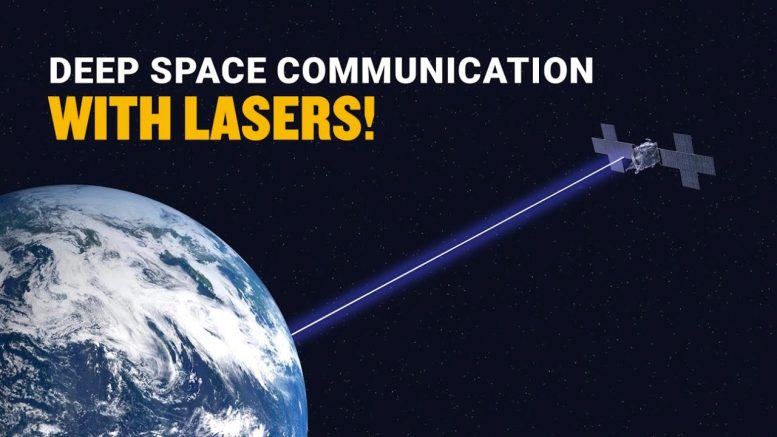
NASA’s DSOC experiment, aboard the Psyche spacecraft, has successfully demonstrated the farthest-ever optical communication using a near-infrared laser from 10 million miles away. This milestone, managed by NASA’s Jet Propulsion Laboratory, marks a significant advancement in space communication technology, promising higher data transmission rates for future deep space missions. Credit: NASA/JPL-Caltech
DSOC, an experiment that could transform how spacecraft communicate, has achieved ‘first light,’ sending data via laser to and from far beyond the Moon for the first time.
NASA’s Deep Space Optical Communications (DSOC) experiment has beamed a near-infrared laser encoded with test data from nearly 10 million miles (16 million kilometers) away – about 40 times farther than the Moon is from Earth – to the Hale Telescope at Caltech’s Palomar Observatory in San Diego County, California. This is the farthest-ever demonstration of optical communications.
Riding aboard the recently launched Psyche spacecraft, DSOC is configured to send high-bandwidth test data to Earth during its two-year technology demonstration as Psyche travels to the main asteroid belt between Mars and Jupiter. NASA’s Jet Propulsion Laboratory (JPL_ in Southern California manages both DSOC and Psyche.
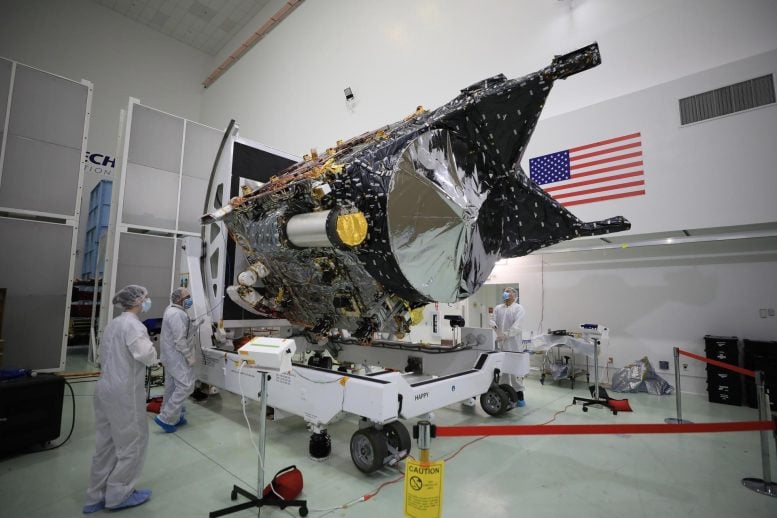
NASA’s Psyche spacecraft is shown in a clean room at the Astrotech Space Operations facility near the agency’s Kennedy Space Center in Florida on December 8, 2022. DSOC’s gold-capped flight laser transceiver can be seen, near center, attached to the spacecraft. Credit: NASA/Ben Smegelsky
The tech demo achieved “first light” in the early hours of November 14 after its flight laser transceiver – a cutting-edge instrument (see image below) aboard Psyche capable of sending and receiving near-infrared signals – locked onto a powerful uplink laser beacon transmitted from the Optical Communications Telescope Laboratory at JPL’s Table Mountain Facility near Wrightwood, California. The uplink beacon helped the transceiver aim its downlink laser back to Palomar (which is 100 miles, or 130 kilometers, south of Table Mountain) while automated systems on the transceiver and ground stations fine-tuned its pointing.
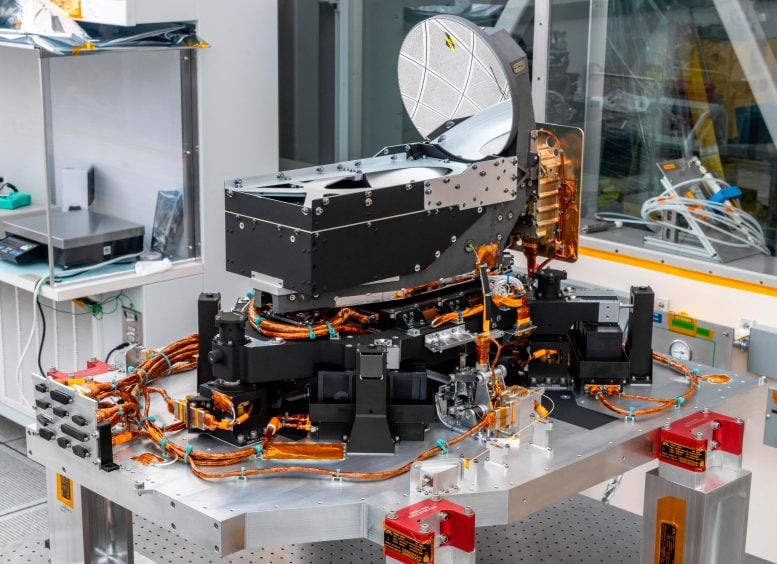
The Deep Space Optical Communications (DSOC) technology demonstration’s flight laser transceiver is shown at NASA’s Jet Propulsion Laboratory in Southern California in April 2021, before being installed inside its box-like enclosure that was later integrated with NASA’s Psyche spacecraft. The transceiver consists of a near-infrared laser transmitter to send high-rate data to Earth, and a sensitive photon-counting camera to receive ground-transmitted low-rate data. The transceiver is mounted on an assembly of struts and actuators – shown in this photograph – that stabilizes the optics from spacecraft vibrations. Credit: NASA/JPL-Caltech
“Achieving first light is one of many critical DSOC milestones in the coming months, paving the way toward higher-data-rate communications capable of sending scientific information, high-definition imagery, and streaming video in support of humanity’s next giant leap: sending humans to Mars,” said Trudy Kortes, director of Technology Demonstrations at NASA Headquarters in Washington.
Test data also was sent simultaneously via the uplink and downlink lasers, a procedure known as “closing the link” that is a primary objective for the experiment. While the technology demonstration isn’t transmitting Psyche mission data, it works closely with the Psyche mission-support team to ensure DSOC operations don’t interfere with those of the spacecraft.
Learn more about how DSOC will be used to test high-bandwidth data transmission beyond the Moon for the first time – and how it could transform deep space exploration. Credit: NASA/JPL-Caltech/ASU
“Tuesday morning’s test was the first to fully incorporate the ground assets and flight transceiver, requiring the DSOC and Psyche operations teams to work in tandem,” said Meera Srinivasan, operations lead for DSOC at JPL. “It was a formidable challenge, and we have a lot more work to do, but for a short time, we were able to transmit, receive, and decode some data.”
Before this achievement, the project needed to check the boxes on several other milestones, from removing the protective cover for the flight laser transceiver to powering up the instrument. Meanwhile, the Psyche spacecraft is carrying out its own checkouts, including powering up its propulsion systems and testing instruments that will be used to study the asteroid Psyche when it arrives there in 2028.
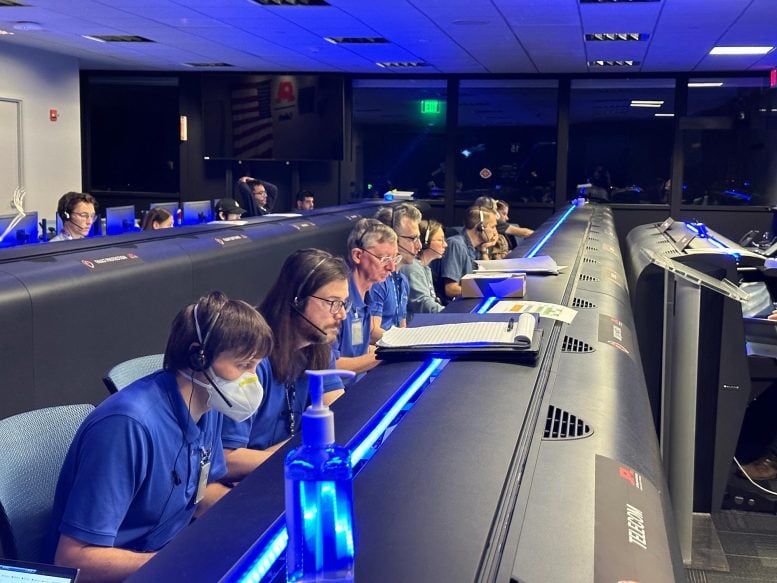
The flight laser transceiver operations team for NASA’s Deep Space Optical Communications (DSOC) technology demonstration works in the Psyche mission support area at JPL in the early hours of November 14, when the project achieved “first light.” Credit: NASA/JPL-Caltech
First Light and First Bits
With successful first light, the DSOC team will now work on refining the systems that control the pointing of the downlink laser aboard the transceiver. Once achieved, the project can begin its demonstration of maintaining high-bandwidth data transmission from the transceiver to Palomar at various distances from Earth. This data takes the form of bits (the smallest units of data a computer can process) encoded in the laser’s photons – quantum particles of light. After a special superconducting high-efficiency detector array (see image below) detects the photons, new signal-processing techniques are used to extract the data from the single photons that arrive at the Hale Telescope.
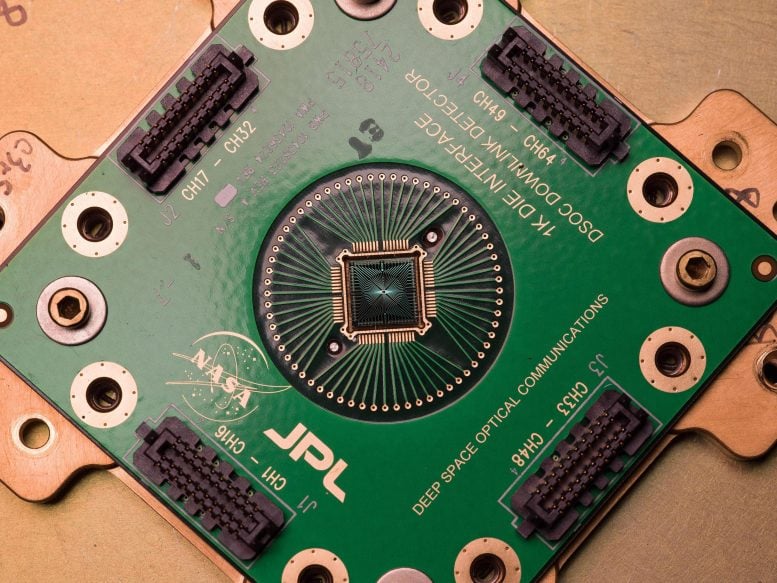
Shown here is an identical copy of the Deep Space Optical Communications, or DSOC, superconducting nanowire single-photon detector that is coupled to the 200-inch (5.1-meter) Hale Telescope located at Caltech’s Palomar Observatory in San Diego County, California. Built by the Microdevices Laboratory at NASA’s Jet Propulsion Laboratory in Southern California, the detector is designed to receive near-infrared laser signals from the DSOC flight transceiver traveling with NASA’s Psyche mission in deep space as a part of the technology demonstration. Credit: NASA/JPL-Caltech
The DSOC experiment aims to demonstrate data transmission rates 10 to 100 times greater than the state-of-the-art radio frequency systems used by spacecraft today. Both radio and near-infrared laser communications utilize electromagnetic waves to transmit data, but near-infrared light packs the data into significantly tighter waves, enabling ground stations to receive more data. This will help future human and robotic exploration missions and support higher-resolution science instruments.
“Optical communication is a boon for scientists and researchers who always want more from their space missions, and will enable human exploration of deep space,” said Dr. Jason Mitchell, director of the Advanced Communications and Navigation Technologies Division within NASA’s Space Communications and Navigation (SCaN) program. “More data means more discoveries.”
While optical communication has been demonstrated in low Earth orbit and out to the Moon, DSOC is the first test in deep space. Like using a laser pointer to track a moving dime from a mile away, aiming a laser beam over millions of miles requires extremely precise “pointing.”
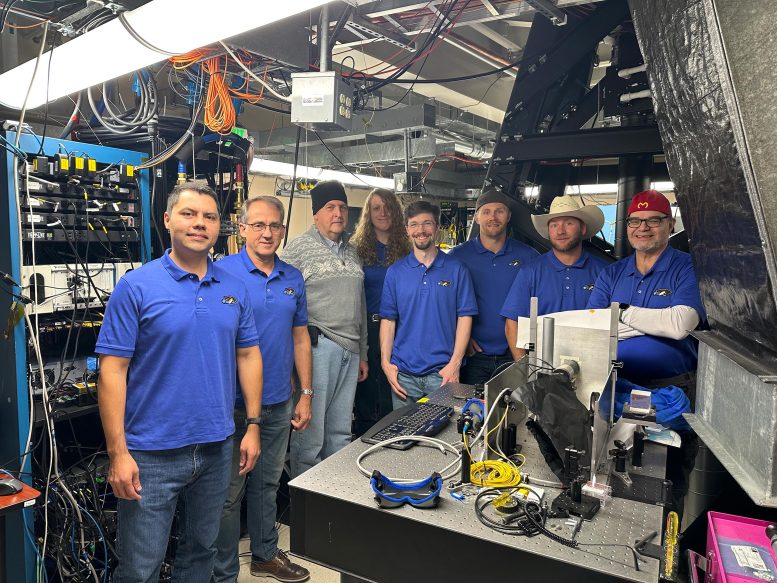
DSOC ground laser transmitter operators pose for a photo at the Optical Communications Telescope Laboratory at JPL’s Table Mountain Facility near Wrightwood, California, shortly after the technology demonstration achieved “first light” on November 14. Credit: NASA/JPL-Caltech
The demonstration also needs to compensate for the time it takes for light to travel from the spacecraft to Earth over vast distances: At Psyche’s farthest distance from our planet, DSOC’s near-infrared photons will take about 20 minutes to travel back (they took about 50 seconds to travel from Psyche to Earth during the Nov. 14 test). In that time, both spacecraft and planet will have moved, so the uplink and downlink lasers need to adjust for the change in location.
“Achieving first light is a tremendous achievement. The ground systems successfully detected the deep space laser photons from DSOC’s flight transceiver aboard Psyche,” said Abi Biswas, project technologist for DSOC at JPL. “And we were also able to send some data, meaning we were able to exchange ‘bits of light’ from and to deep space.”
More About the Mission
DSOC is the latest in a series of optical communication demonstrations funded by NASA’s Space Technology Mission Directorate and the Space Communications and Navigation (SCaN) program within the agency’s Space Operations Mission Directorate.
The Psyche mission is led by Arizona State University. JPL is responsible for the mission’s overall management, system engineering, integration and test, and mission operations. Psyche is the 14th mission selected as part of NASA’s Discovery Program under the Science Mission Directorate, managed by the agency’s Marshall Space Flight Center in Huntsville, Alabama. NASA’s Launch Services Program, based at the agency’s Kennedy Space Center, managed the launch service. Maxar Technologies in Palo Alto, California, provided the high-power solar electric propulsion spacecraft chassis.




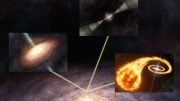
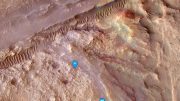



I wonder could this experiment use AI for a adjustment techneek to keep constant movement chagectury of the satellite and earth.
I didn’t realize Dave Grohl from the Foo Fighters was on the flight laser transceiver operations team.
In the map of the American continent, a bird like a simug is flying towards the sky.This great demon spirit was wanted to fall into the space by the head of the world tribe.Suddenly, after hitting the sun, a planet from the galaxy fell on the head and the left wing of the eagle.That safina was torn into pieces and rotted in the soil.The man of the tribe was not left behind, under hundreds of thousands of good soil, we are amazed how this event and disaster came from the galaxy, how did the father of the earth know that the bird’s foot reached the man of the tribe inthe map of Panama.It is in the southern continent of America and the foot of that bird is the country of Panama.How did that planet reach the sun and the earth from the two arms of the galaxy?Hello, I am Dr. Mehrdad.The history of human civilization is the Earth.In 60 million years ago, when the sun reached the side of the Milky Way and the other side of the galaxy, this sad and amazing incident happened and the lives of the earthlings were destroyed because the sun collided with the arm of the galaxy, andthese collisions started several billion years ago.At that time, Mars, Earth, Venus, and Mercury were never next to the Sun, but four very, very heavy giant planets were tens of millions of kilometers and tens of millions of miles away from the Sun.Since the Sun was there, there were no other planets and moons next to the planets.It was not because of the hundreds of rounds that the sun made around the galaxy.400 four hundred planets along with their stars were placed around the sun, of which 170 planets collided with solar bodies.226 of these planets are the planets of the galaxy.Next to that, there are four gas planets, Neptune, 14 fourteen planets from the galaxy.The further we go towards the edge of the sun, because the orbit of the giant gas planets becomes narrower and smaller, the number of moons that were the same planet in the lap of, for example, Uranus is more than Neptune, which has 27planets, Uranus has 27 planets, and Saturn has 83 planets Through the milky arm of the galaxy, they reached the orbits of the planets, which have become smaller, the orbits of the planets near the sun, that’s why the gas planets were closer tothe sun, for example, they reached 102 planets in the lap of Jupiter, which now has so many moons, what will happen to the 4 rocky planets?I said that 226 planets came towards the sun and became the moons of the solar system.In fact, I want to tell you that out of the 400 planets that joined our solar system with their stars, which were originally the 400 solar systems, and 4 planets, Mars, Earth, Venus, Mercury, originally These four planets used to revolvearound four stars in the arm of the galaxy, which joined our solar system with their stars, and with these four planets, the number of planets that came from the arm of the galaxy to the sun is 230 planets, which survived Neptune, Uranus,Saturn and They took Jupiter and didn’t hit these gas giant planets because of their size, gravity and mass, they were at a greater distance from the surface of these gas planets and they didn’t hit the sun.If they were small, they would have hit the sun because they wanted to be in a smaller orbit around their own star.Go around the sun, every star and said planet
Because when the solar system with its planet approaches the sun of our solar system, this collision, the said planet, which revolves around its star, rotates ahead of its star, when the star approaches our sun, the planet collides with the sun.slow But some planets like Earth that came to our sun from the arm of the galaxy are far away from our sun due to their heavy mass and volume, that’s why they didn’t hit our sun.The north and south poles that we are referring to are the positive and negative poles on the planet, which is large, but this is a complicated issue.In the solar system, there are 170 planets that come from the arm of the galaxy, out of the total of 230 planets that have become moons, and four rocky planets are added to 226 planets.That is, 230 plus 170 is 400. Has it happened to them?Some of them hit the sun and caused the destruction of life on earth, or rather caused rebirth on earth.At least two human civilizations have been destroyed on Earth.We dig urban buildings to a depth of several thousand meters, we dig into the urban fabric of buildings that those buildings and urban equipment belonged to the civilizations of several hundred million years ago, those people who live on the ground below several thousand meters of soil.they did It is one of the 170 planets that the sun hit and they disintegrated.I explained earlier that meteorites hitting the surface of the Moon and Sagittarius Mercury were very numerous because so many stars and planets collided with the Sun and then disintegrated.And stars like meteorites hit the surface of the Earth’s moon and the surface of Mercury, and because of this, deep holes were created on the surface of the planet Mercury.I said that 400 four hundred planets and stars have come towards the sun, out of 170 stars and planets, some of them may have escaped from the sun’s gravity and have been directed outside the solar system, and most of the stars that came from thearm of the sun.The galaxy collided with the first gas planets as it entered, such as Neptune, Uranus, Saturn, and Jupiter, causing their gas to merge with that of the gas planets, and when stars smaller than the Sun formed from the arm of the galaxy intofour planets.which I named collided and caused these four gas planets to rotate around themselves in less than 24 hours and Jupiter to rotate around itself in less than 10 hours in one day and night at a speed of 45,000 km per hour, this speed is 25 times thespeed of rotation The earth rotates, the earth rotates at a speed of less than 1700 km/h in 24 hours.In the next comments, I will talk about the stars and planets of these stars, which are 400 in number, which is the reason for the reverse rotation of Venus.As a result of the collision of several small planets, this planet collides with the planet, its rotation slows down, and if the number of small planets with a large planet such as Venus is large, it causes it to rotate and reverse.It takes 243 days for the planet to rotate around itself in one day and night on Venus, Dr. Mehrdad from America, send me a message and tell me how fast the two big arms of the galaxy rotate.My email is not working due to sabotage by the criminal regime of the Islamic Republic.is a dictator.I can’t connect to NASA website and other famous websites.May God protect your loved ones.I wish you success and victory in all stages of your life.PhD in Astrology and Religions and Author 00989332197646 Agha Kisiri Tehran
موقع ترجمه متن بعضی از کلمات را جمهوری اسلامی خراب کرده من نمیتوانم درست کنم اگر باشد کتابمو مییایم
Read “I Robot” by Isaac Asimov and have a big smile
Hello, Chris Behler, Buhler means stainless steel, you have an interesting family, Mr. Chris, probably your fathers were in the business of producing stainless steel, I mean steel that never rusts. Regarding Isaac Asimov, I must say that I read the books of this Russian scientist and author when I was 17 years old. I read and read the books of Maurice Maeterlin, Eric Van Donnie, and Albert Einstein, which were about the fourth dimension and the refraction of light, and the book on Astrophysics, which explained about the structure of the atom, in the same year 1360. I am now exactly 60 years old, count and tell me. How old am I now? I was born in the year Abjad. With the found time, they made me the owner of their time and their prophet. For more information, check my mobile number and enter it in Google to see what sites and websites are opened. I thank God for everything they did, but I am not financially free at the moment. That my paternal family are all doctors and my brothers and sisters are dentists, but we are empty handed, but all the power of the devil is in our possession and at our command, but the mullahs of Haram Al Qamah also have the power of God, not the power of the spirits of animals and the devil, and the devil is from the sheikh and The mullahs command, be sure to enter my number in Google and help us in order to appear. There are several steps. Send my mobile number to all the important sites. To send the pictures that I took before the helicopter of the president of Iran fell, I need to send these pictures that The devil has created the clouds from the impact of the helicopter on my mountain
sahebzaman doctor mehrdad kasiri darabad masih danshvary 00989332197646 time 13:00